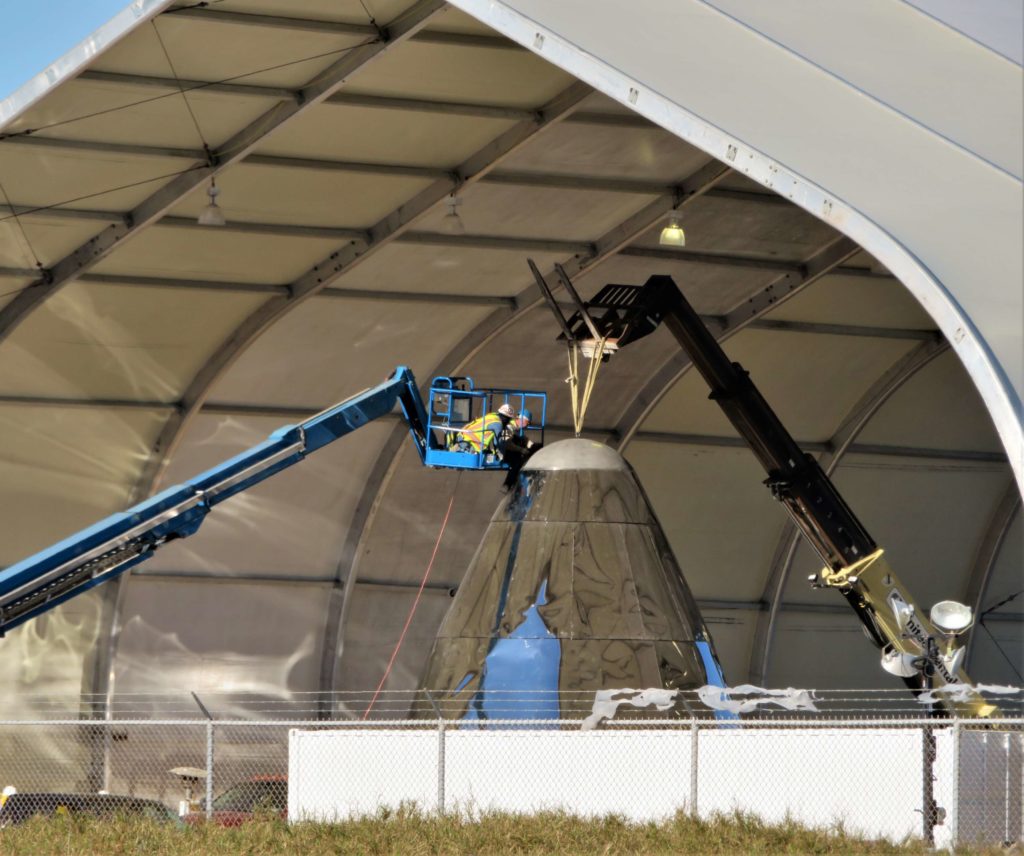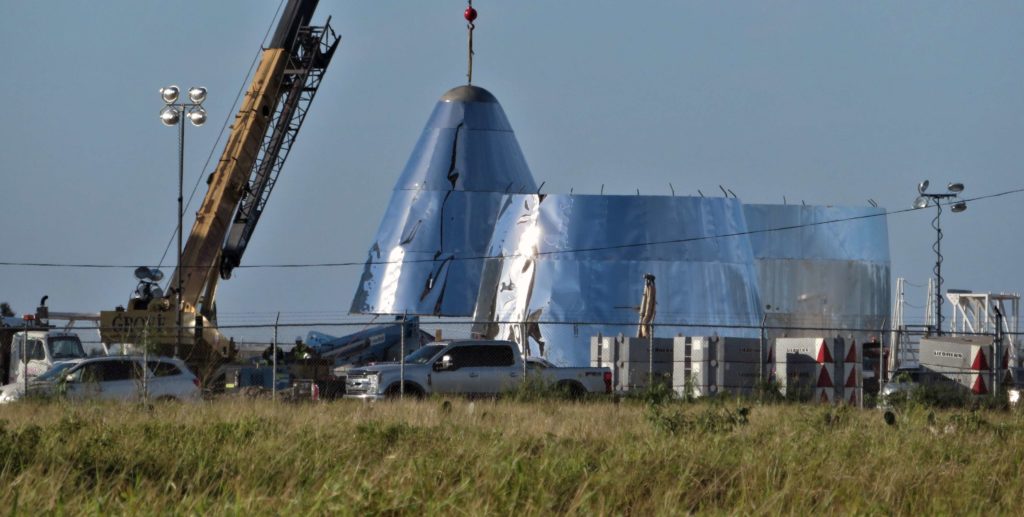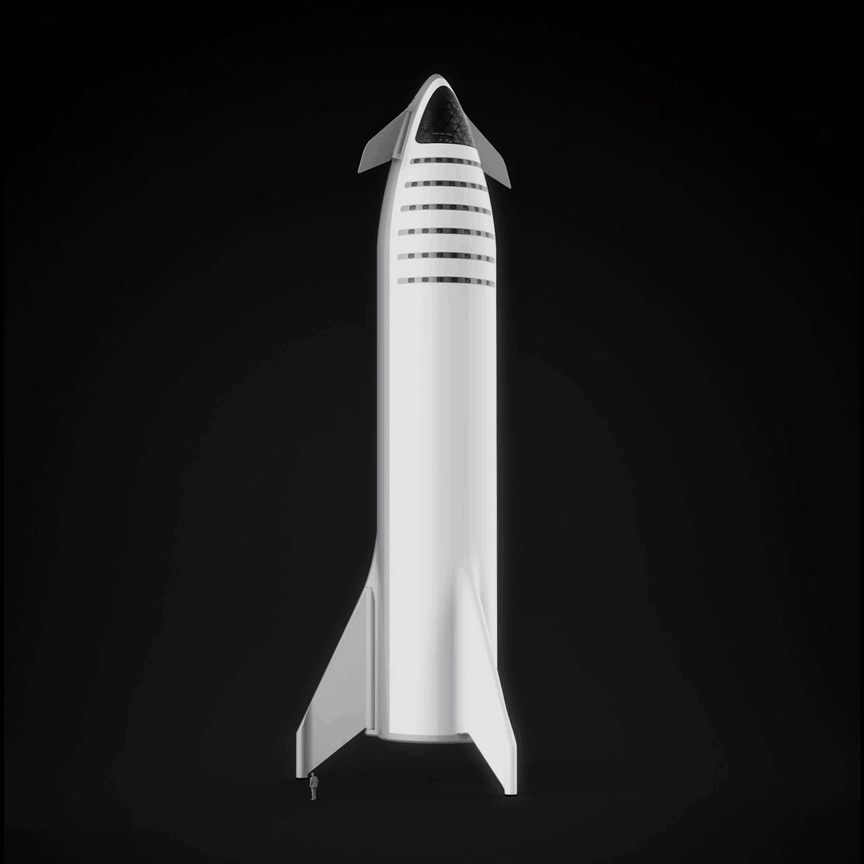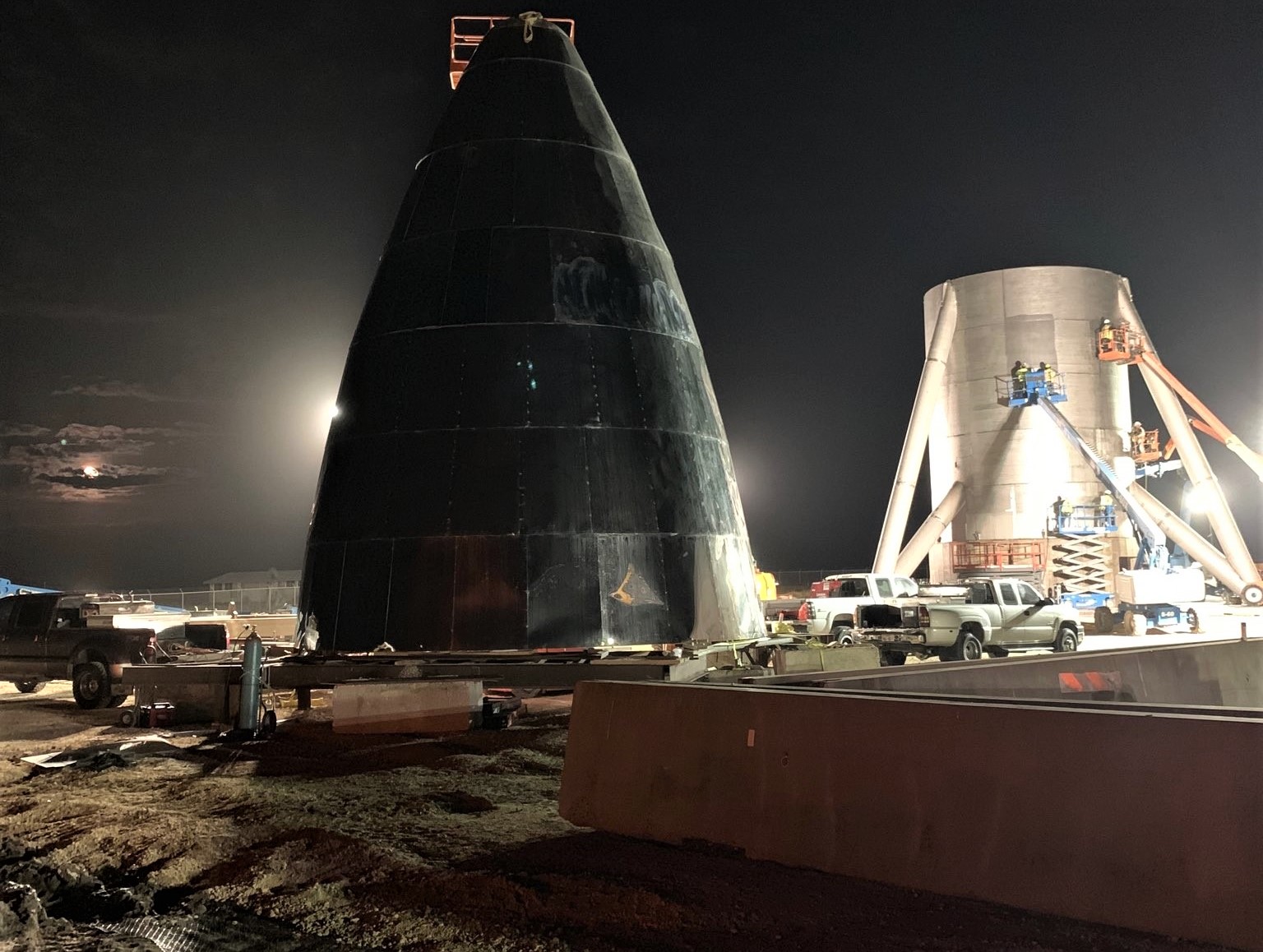
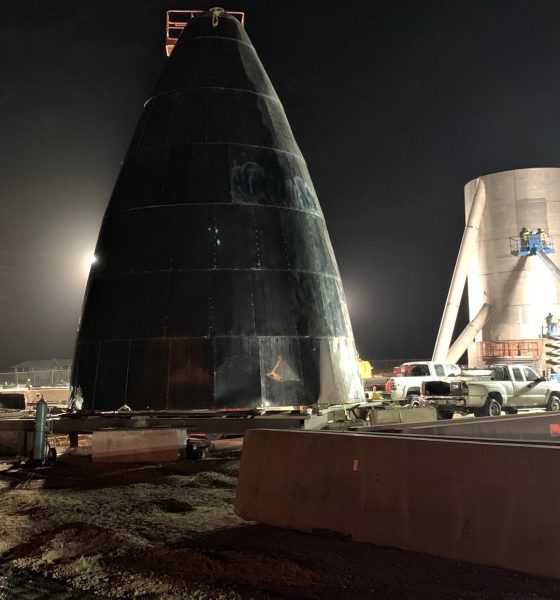
SpaceX
SpaceX CEO Elon Musk: Starship prototype to have 3 Raptors and “mirror finish”
Taking to Twitter once more to reveal additional information about SpaceX’s radically changing BFR/Starship prototype program, CEO Elon Musk has made an unexpected visit to the company’s South Texas BFR testing facilities to oversee rapid progress with a low-fidelity hop test prototype of the orbital Starship spacecraft.
Included in a handful of replies that followed the tweeted image, Musk described some of the key advantages of a stainless steel Starship – including mirror-like thermal reflectivity for hot reentries and a “usable” strength-to-mass ratio superior to carbon fiber – as well as features of prototype cousin.
Stainless Steel Starship pic.twitter.com/rRoiEKKrYc
— Elon Musk (@elonmusk) December 24, 2018
While the CEO did imply on Saturday that the Mars-focused Raptor engine had been what he described as “radically redesigned”, Musk’s statement that the Starship hopper will feature three Raptor engines does at least set a lower bound for the ship’s maximum gross takeoff weight when the time comes for it to take flight.
Yes. Radically redesigned Raptor ready to fire next month.
— Elon Musk (@elonmusk) December 22, 2018
While the suggestion that Raptor’s turbopumps (basically fuel pumps) would need at least 100,000 HP per engine seems to indicate that the flight design’s thrust has been appreciably uprated, a past figure of ~2000 kN (450,000 lbf) per engine suggests that Starship V0.1 could weigh as much as an entire Falcon 9 Block 5 rocket (~1.2 million pounds, 550,000 kg) and still having a solid 80-100% of Falcon 9’s liftoff thrust. Put simply, the rocket that appears to be coming together in the boonies of South Texas could rival almost any other liquid fuel rocket booster in service, while still being the testbed for BFR’s upper stage alone.
While it’s ambiguous if several additional comments applied to the Starship prototype, the final product, or both, Musk also indicated that some of the biggest benefits of a shift away from carbon composites to stainless steel would be relative ease with which the material handles extreme heating. Thanks to the fact that stainless steel can ultimately be polished to mirror-like levels of reflectivity and that mirrors are some of the most efficient reflectors of thermal energy (heat), shiny and unpainted steel would ultimately perform far better than carbon composites and could end up requiring “much less” heat shielding for the same performance.
- ¯\_(ツ)_/¯ (bocachicagal – NASASpaceflight)
- A conspicuous nosecone appears to have arisen inside SpaceX’s new Boca Chica tent, adjacent to what looks like a water tower with tube legs. (bocachicagal – NASASpaceflight)
- Boca Chica, 12/23/18. (NASASpaceflight /u/bocachicagal)
- It remains to be seen if BFR can be made as reusable and reliable as it will need to be to sustainably support interplanetary humans. (SpaceX)
- Starship – in its 2018 design iteration – seen landing on Mars atop pillars of Raptor flame. (SpaceX)
Perhaps most unintuitive is the fact that steel can apparently beat carbon composites when it comes to usable strength-to-weight ratios at supercool temperatures. According to Musk, steel also performs “vastly better” at high temperatures and appreciably better at room temperatures. A comment made on Saturday may lend additional credence to what seems at face value to contradict basic material intuition – at least some of the stainless steel SpaceX is examing would be a special (presumably SpaceX-engineered) alloy that has undergone what is known as cryogenic treatment, in which metals are subjected to extremely cold conditions to create some seriously unintuitive properties. Ultimately, cold-formed/worked or cryo-treated steel can be dramatically lighter and more wear-resistant than traditional hot-rolled steel.
Usable strength/weight of full hard stainless at cryo is slightly better than carbon fiber, room temp is worse, high temp is vastly better
— Elon Musk (@elonmusk) December 24, 2018
Combined with advanced new alloys and a uniquely strong handle on working with supercool propellant (likely transferable to cold-forming steel), SpaceX and CEO Elon Musk could have a true breakthrough on their hands, especially if it turns out that a great deal of deep thought, analysis, and refinement fed into these “radical” design changes. With Starship Alpha’s hop tests potentially beginning as early as March 2019, we won’t have long to wait to find out.
For prompt updates, on-the-ground perspectives, and unique glimpses of SpaceX’s rocket recovery fleet check out our brand new LaunchPad and LandingZone newsletters!

Elon Musk
Starlink passes 9 million active customers just weeks after hitting 8 million
The milestone highlights the accelerating growth of Starlink, which has now been adding over 20,000 new users per day.

SpaceX’s Starlink satellite internet service has continued its rapid global expansion, surpassing 9 million active customers just weeks after crossing the 8 million mark.
The milestone highlights the accelerating growth of Starlink, which has now been adding over 20,000 new users per day.
9 million customers
In a post on X, SpaceX stated that Starlink now serves over 9 million active users across 155 countries, territories, and markets. The company reached 8 million customers in early November, meaning it added roughly 1 million subscribers in under seven weeks, or about 21,275 new users on average per day.
“Starlink is connecting more than 9M active customers with high-speed internet across 155 countries, territories, and many other markets,” Starlink wrote in a post on its official X account. SpaceX President Gwynne Shotwell also celebrated the milestone on X. “A huge thank you to all of our customers and congrats to the Starlink team for such an incredible product,” she wrote.
That growth rate reflects both rising demand for broadband in underserved regions and Starlink’s expanding satellite constellation, which now includes more than 9,000 low-Earth-orbit satellites designed to deliver high-speed, low-latency internet worldwide.
Starlink’s momentum
Starlink’s momentum has been building up. SpaceX reported 4.6 million Starlink customers in December 2024, followed by 7 million by August 2025, and 8 million customers in November. Independent data also suggests Starlink usage is rising sharply, with Cloudflare reporting that global web traffic from Starlink users more than doubled in 2025, as noted in an Insider report.
Starlink’s momentum is increasingly tied to SpaceX’s broader financial outlook. Elon Musk has said the satellite network is “by far” the company’s largest revenue driver, and reports suggest SpaceX may be positioning itself for an initial public offering as soon as next year, with valuations estimated as high as $1.5 trillion. Musk has also suggested in the past that Starlink could have its own IPO in the future.
News
SpaceX shades airline for seeking contract with Amazon’s Starlink rival

SpaceX employees, including its CEO Elon Musk, shaded American Airlines on social media this past weekend due to the company’s reported talks with Amazon’s Starlink rival, Leo.
Starlink has been adopted by several airlines, including United Airlines, Qatar Airways, Hawaiian Airlines, WestJet, Air France, airBaltic, and others. It has gained notoriety as an extremely solid, dependable, and reliable option for airline travel, as traditional options frequently cause users to lose connection to the internet.
Many airlines have made the switch, while others continue to mull the options available to them. American Airlines is one of them.
A report from Bloomberg indicates the airline is thinking of going with a Starlink rival owned by Amazon, called Leo. It was previously referred to as Project Kuiper.
American CEO Robert Isom said (via Bloomberg):
“While there’s Starlink, there are other low-Earth-orbit satellite opportunities that we can look at. We’re making sure that American is going to have what our customers need.”
Isom also said American has been in touch with Amazon about installing Leo on its aircraft, but he would not reveal the status of any discussions with the company.
The report caught the attention of Michael Nicolls, the Vice President of Starlink Engineering at SpaceX, who said:
“Only fly on airlines with good connectivity… and only one source of good connectivity at the moment…”
CEO Elon Musk replied to Nicolls by stating that American Airlines risks losing “a lot of customers if their connectivity solution fails.”
American Airlines will lose a lot of customers if their connectivity solution fails
— Elon Musk (@elonmusk) December 14, 2025
There are over 8,000 Starlink satellites in orbit currently, offering internet coverage in over 150 countries and territories globally. SpaceX expands its array of satellites nearly every week with launches from California and Florida, aiming to offer internet access to everyone across the globe.
Currently, the company is focusing on expanding into new markets, such as Africa and Asia.
News
Tesla hints at Starlink integration with recent patent
“By employing polymer blends, some examples enable RF transmission from all the modules to satellites and other communication devices both inside and outside the vehicle.”

Tesla hinted at a potential Starlink internet terminal integration within its vehicles in a recent patent, which describes a vehicle roof assembly with integrated radio frequency (RF) transparency.
The patent, which is Pub. No U.S. 2025/0368267 describes a new vehicle roof that is made of RF-transparent polymer materials, allowing and “facilitating clear communication with external devices and satellites.”
Tesla believes that a new vehicle roof design, comprised of different materials than the standard metallic or glass elements used in cars today, would allow the company to integrate modern vehicular technologies, “particularly those requiring radio frequency transmission and reception.
Tesla has recently filed a US patent application on integrating RF transparent materials into the roof structure.
“facilitating clear communication with external devices and satellites”
Tesla fleet is getting @Starlink connectivity integration soon. LFG @Tesla @elonmusk… pic.twitter.com/bLa8YtPLd1
— Chansoo Byeon (@Chansoo) December 9, 2025
Instead of glass or metallic materials, Tesla says vehicles may benefit from high-strength polymer blends, such as Polycarbonate, Acrylonitrile Butadiene Styrene, or Acrylonitrile Styrene Acrylate.
These materials still provide ideal strength metrics for crashworthiness, stiffness for noise, vibration, and harshness control, and are compliant with head impact regulations.
They would also enable better performance with modern technologies, like internet terminals, which need an uninterrupted signal to satellites for maximum reception. Tesla writes in the patent:
“By employing polymer blends, some examples enable RF transmission from all the modules to satellites and other communication devices both inside and outside the vehicle.”

One of the challenges Tesla seems to be aware of with this type of roof design is the fact that it will still have to enable safety and keep that at the forefront of the design. As you can see in the illustration above, Tesla plans to use four layers to increase safety and rigidity, while also combating noise and vibration.
It notes in the patent that disclosed examples still meet the safety requirements outlined in the Federal Motor Vehicle Safety Standards (FMVSS).
Starlink integrated directly into Tesla vehicles would be a considerable advantage for owners. It would come with a handful of distinct advantages.
Initially, the inclusion of Starlink would completely eliminate cellular dead zones, something that is an issue, especially in rural areas. Starlink would provide connectivity in these remote regions and would ensure uninterrupted service during road trips and off-grid adventures.
It could also be a critical addition for Robotaxi, as it is crucial to have solid and reliable connectivity for remote monitoring and fleet management.
Starlink’s growing constellation, thanks to SpaceX’s routine and frequent launch schedule, will provide secure, stable, and reliable internet connectivity for Tesla vehicles.
Although many owners have already mounted Starlink Mini dishes under their glass roofs for a similar experience, it may be integrated directly into Teslas in the coming years, either as an upgrade or a standard feature.

